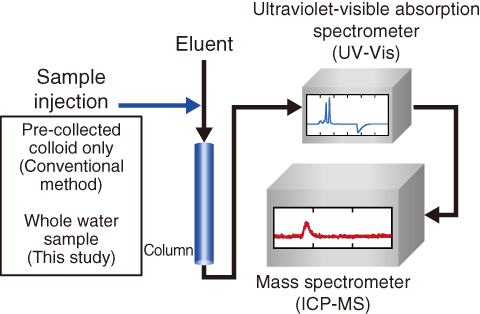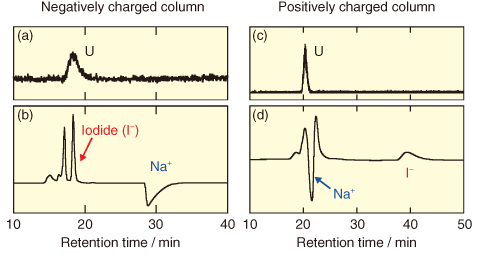
Fig.3-12 SEC-UV-Vis-ICP-MS analysis

Fig.3-13 SEC-UV-Vis-ICP-MS analysis of Horonobe groundwater
It is thought that actinides do not migrate in environmental water (EW) in ionic form, but rather, migrate together with colloids by being adsorbed onto them. However, this theory has not yet been experimentally confirmed because there have not been any methods for effectively investigating trace actinides in EW and thereby determining what colloids transport them and whether actinide ions can migrate by themselves.
The SEC-UV-Vis-ICP-MS method has been used to analyze colloids in EW. This method separates colloids by their sizes and detects trace elements in them (Fig.3-12). In the conventional method, relatively large colloids in EW are collected in advance, and are then injected into a separation column for analysis. This method has the disadvantage of being incapable of analyzing ions and small colloids. To solve these problems, we took note of the charge of the separation columns. By injecting EW as it is into a separation column, actinides in all states are detected. Since colloids and ions are separated by sizes and charges, respectively, it is predicted that colloids and ions can be distinguished by comparing the two results obtained by columns with opposite charges.
We analyzed trace uranium (U) in the groundwater collected at Horonobe, Hokkaido (Fig.3-13). A single peak of U was detected by each column. The sizes of the uranium-bearing substances, estimated from the times when the peaks appeared, were very similar to each other. This result shows that U was present as a colloid.
Trace U does not form an intrinsic (true) colloid. All the silica contained abundantly in the groundwater was eluted with U. This result revealed that U was present as a pseudocolloid, which comprised U adsorbed onto silica colloid. To our knowledge, we are the first to have discovered this type of pseudocolloid of U. The results also revealed that this groundwater did not contain U ions, because no other U peaks were detected.
This study devised a powerful analytical method for elucidating the forms of trace actinides in EW. This method is broadly applicable to various water samples, including experimental samples, and future application in various research fields is expected.